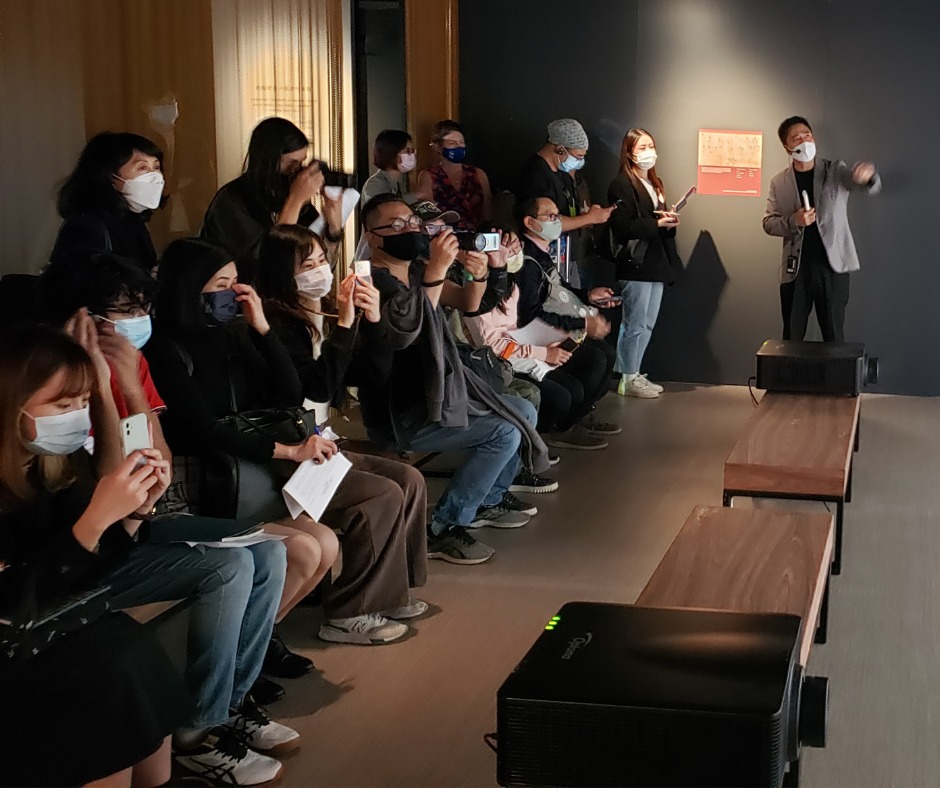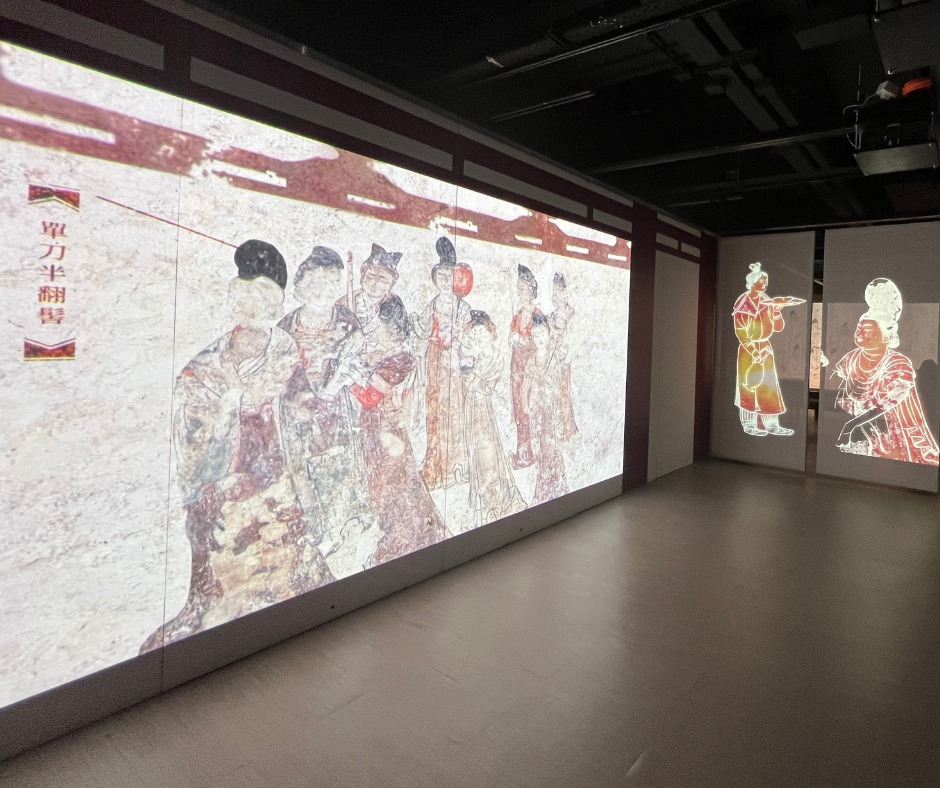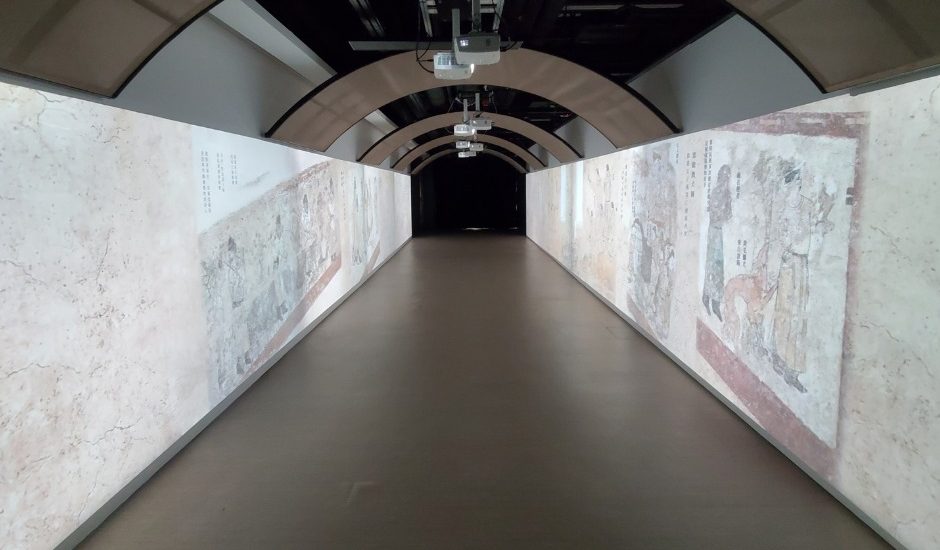There is a certain poetry in unearthing the vast world of an entire era of Chinese society, culture, politics, and power by using digitization technology on the murals of dead princes and nobles. The exhibit, “A Glimpse of Tang Prosperity from Murals—The Exhibition Tour on Murals of the Tang Dynasty,” features what I would call a modern mausoleum museology experience, recreating an otherworldly yet welcoming ambience through mixed media like music, short films, and animations. The design team deployed light projection technology to recombine the restored art (which were previously detached fragments) of the Zhaoling Mausoleum (tomb of Emperor Taizong), the Qianling Mausoleum (tomb of Gaozong, Wu Zetian, and several other members of the imperial household), and its seventeen tombs. This recombination has allowed the recreation of how the murals first appeared on the mausoleum passageways, ceilings, walls, and tunnels. The digital displays are enhanced by text highlighting features of note and nuances.
“The High Tang period was an age of self-confidence, openness, and curiosity. It is a period of Chinese history unlike any other and should be studied more by everyone.” This is what Davis Leung, curator of suggested as he took me on a tour around this exhibit at The Indra and Harry Banga Gallery (which in turn is located at City University of Hong Kong). “We wanted to showcase the booming vitality that characterized the High Tang in almost every aspect of Chinese life, from openness to foreign influence to the seriousness of court life; from the flowering of aesthetic tastes to the outward-looking attitudes of artists, musicians, and statesmen.”

Altogether, 42 imperial murals are featured in this exhibit. It ran from December 2021 to February 2022 but has been extended to 12 June, and was organized by the China Soong Ching Ling Foundation, the National Cultural Heritage Administration, the Shaanxi Provincial Cultural Heritage Administration, and the Hong Kong Rosamond Foundation. This exhibit had been shown in Taiwan and Macau before taking its place at the Gallery in Hong Kong. The co-organisers were the Shaanxi History Museum and the Shaanxi Cultural Heritage Promotion Association.
Specifically, what historians call the High Tang encompass the Zhenguan (627–49) and Kaiyuan (712–56) eras, seen by many as the apogee of the Tang as well as a golden age for Imperial China. The mausoleums themselves are a remarkable feat of Chinese funerary architecture. Davis Leung wrote in an introduction to the exhibit, “Few Tang murals in buildings above ground have survived the ravages of time, whereas the tomb murals have been perfectly preserved. . . . Each tomb features a long sloping passageway, multiple cupolas, tunnels, and a front and a rear chamber. The various components symbolize the luxurious palatial complexes and interior spaces enjoyed by the tomb occupant in life.”
Each occupant, of course, was a complex historical character, enjoying glory and suffering indignity alike. Take Crown Prince Li Hong (652–75), whose tomb features some of the most vivid mural art. He was rumoured to have been murdered at the orders of his own mother, China’s only empress, Wu Zetian. The same applies to the resting places of imperial clan members Li Xian (Wu Zetian’s son), Li Chongrun (her grandson), and Li Xianhui (daughter of Emperor Zhongzhong and Empress Wei), whose adorned tombs were lovingly decorated by anonymous professionals: Li Xianhui also died reportedly by order of Wu Zetian, sacrificed ruthlessly in the name of consolidating Empress Wu’s usurpation of the Li imperial clan.

The murals are divided into three “thematic animation zones”: etiquette and ceremonies, hunting and leisure, and court life, before concluding with a long tunnel that displays all of the restored art in varying order. I enjoyed immensely my tour of the zones, with Davis Leung explaining the polo mural at the hunting and leisure zone. “The earliest visual representation of polo is right here, in this artistic depiction,” he said, noting that such first-hand evidence helps to corroborate textual records and give historians and the general public a better idea of what life might have looked like then. The mural itself, through light projection technology, was animated, with the individual polo players and their horses moving about.
The court life zone featured a dancing Uighur, who performed to an ensemble of musicians playing an array of exquisite music. Davis Leung noted: “Instruments with an oval shape, such as the pipa, were introduced from non-Han cultures, most likely from the steppe societies that the Tang aristocracy, military, and merchants had contact with. And you can see how many of the musicians in this troupe are playing non-Han instruments that have been incorporated into the repertoire of what we call Chinese music.” And in the etiquette and ceremonies zone, he pointed out how the garments of officials, the diverse fashion (including the common practice of cross-dressing and masculine wear for going downtown) and makeup of Tang women point toward a cosmopolitanism that is embodied by Chang’an, which was at its height a melting pot of religions like Buddhism, Manicheanism, and Nestorian Christianity, a beating heart of economic muscle (especially in the high streets of the Eastern Street and Western Street), and multicultural encounters between Sogdian businessmen, Chinese officials, and Uighur mercenaries.
In death, the perennial concern of Buddhism (and all great religions), departed historical figures reveal to us their stories thanks to the people that determined not to let their memory be lost. The architects of the mausoleums and the artists that worked on their interiors were, of course, professionals. However, whatever they might have personally thought about the deceased occupants, the reverence for at least the afterlife that these imperial names would step into is palpable. The realism, detail, and care given to the murals are a world to endlessly explore, and the exhibit was one small step in helping amateurs like myself grasp, if only partially, the immensity of the High Tang’s significance for China and today’s broader human heritage.
See more
Introduction: An Underground Museum of the High Tang Period (City University of Hong Kong)
Tang Dynasty murals showcased at multimedia CityU exhibition (City University of Hong Kong)
Related features from Buddhistdoor Global
The Buddha at Sea: Atlas of Maritime Buddhism and New Experiences in Museology


